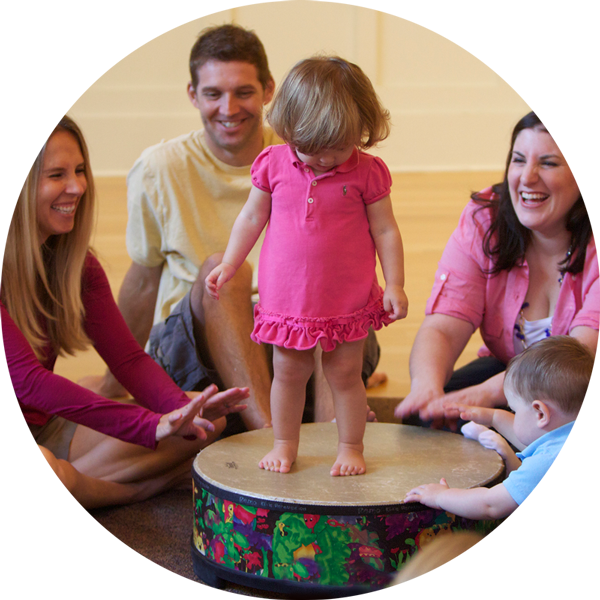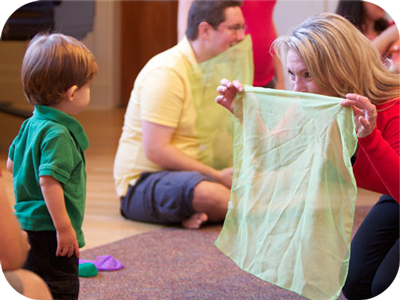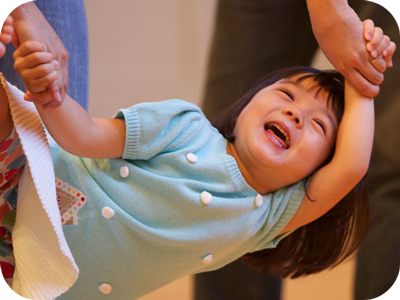Tuning In to How Your Child Learns

Look around a Music Together class and you'll notice different behavioral "personalities." Some children sit still and stare at their parent or teacher singing "Obwisana." Others gaze out the window or look at their toes while the class marches and sings "Lukey's Boat." And some are constantly in motion, jumping or toddling around exuberantly, even when everyone else is in a close circle quietly singing "Who's That?" Do you recognize your child in any of these examples?
My own child, Amy, would sit on my lap in class and just watch—even during the play-along! I asked our teacher if we should we take a break from Music Together. Amy just didn't seem to be having fun like the other kids. "I'm curious," our teacher asked, "What does she do with the music at home?" At home? SO much more! As soon as we left class, she would talk about how much fun it was and start singing up a storm. I was frustrated. "Why can't she be like that in class?" I thought. But with our teacher's guidance, I realized that when Amy was watching in class, she was learning, too. She needed to observe during class and then experiment at home. Our teacher showed me how to support Amy's learning style—and, suddenly, class became a lot more fun for both of us!
Tuning in to the way your child learns can help you "turn up" their learning. It can also help you relax and have more fun.
We see three main learning styles in young children: visual, auditory, and kinesthetic. Howard Gardner, who developed Multiple Intelligence Theory, understood that children learn by using a combination of all their senses, but that most children naturally favor one. That primary sensory "channel" is the strongest way for the child to tune into an experience and learn. Here's a guide to help you start to identify the way your child learns best, whether your family is enrolled in a parent-child class or your child participates in Music Together at their school.
Visual Learner: “I tune into learning best when I watch intently.”

-
What this looks like in a Music Together class: Child stares at parent's or teacher's mouth during singing. Child starts bouncing when we "flash" our hands to the beat. Child moves close to others during an activity to get a front-row seat.
-
Commonly misunderstood as: Not participating, not social.
-
How to support: Make sure to move rhythmically while you sing. Show your child the beat in your torso, gestures, and feet. Exaggerate your mouth and facial expressions while you sing.
-
Resist the urge to interrupt your child's focus by trying to get them to drum with you, sing with you, etc.
Auditory Learner: “I tune into learning best by focusing on what I hear.”
-
What this looks like in class: Child's gaze is off to the side or unfocused. Child may also engage frequently in singing or vocal play, enjoying the sound of their own voice. Out of class, child may tell parent, "Don't sing!" with the recording to avoid having two competing auditory sources.
-
Commonly misunderstood as: Spacing out, not engaged in the music activity, shy.
-
How to support: In class and at home, echo tonal patterns close to one ear and then the other. Clap or tap the beat audibly while you sing. Include pauses in your music-play (like before the "Whooaaa!" in "Trot Old Joe").
-
Resist the urge to try to get your child to do certain things, like make eye contact with you, move their body, or play an instrument when they appear to be deeply listening.
Kinesthetic Learner: “I tune into learning best when I am moving my whole body.”

-
What this looks like in class: Child toddles around the room for an extended period of time. Child often stands and bounces during activities. Child delights in being rocked, spun, dipped, and lifted by parent. Child may not want to sit with parent, may push parent away.
-
Commonly misunderstood as: Off-task, too rowdy, disruptive, too active for music class.
-
How to support: As long as they're safe, allow your child freedom to experience and respond to the music with their whole body. Play the recording at home as well as in the car to give regular opportunities for whole-body music-play.
-
Resist the urge to try to make your child sit down and "pay attention."
Resources for Deeper Learning
|
Once you've identified your child's learning style, you might be tempted to over-focus on supporting that one sense. But, as Gardner says, children are not mono-sensory. They need a balanced sensory diet. Music Together activities naturally provide multi-sensory learning opportunities, connecting parents and children with visual, auditory, and kinesthetic stimulation and support. This ensures that your child gets a whole brain/body experience with music—and so do you!
Understanding my child's dominant learning style was an "Aha!" moment for me as a parent. Most of the time, observing first was how Amy engaged in all kinds of learning. Learning this changed the way I interacted with her not only in Music Together class, but also at birthday parties, library storytime, and even bath time! I felt more in tune with my child and more confident as a parent. Fourteen years later, I'm still using what I learned in my parenting and in my teaching. Tuning into your child's way of learning and processing makes the journey a lot richer, more relaxed, and much more fun!
Devi Borton, M.A., is a Certified Music Together Teacher Trainer and Center Director of FAM JAM! Music Together in Santa Fe, New Mexico.



